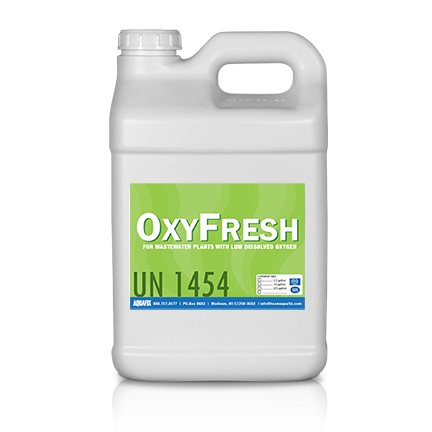OxyFresh
OxyFresh is a liquid source of oxygen that eliminates low DO (dissolved oxygen) conditions, filaments, odors, and septicity. Providing a system with an additional oxygen source will lead to a reduction in bulking filaments like Thiothrix spp., Type 021N, and H. hydrossis, and Sphaerotilus natans/Type 1701. Use OxyFresh anywhere low DO conditions exist (such as activated sludge plants, aeration basins, and lift stations).
Enhances Oxygen Levels: Increases the ORP in wastewater systems to limit symptoms of low DO.
Improves Settling: Mitigates the growth of low DO filaments.
Neturalizes Odors: Effectively reduces odors related to septicity and integrates odor neutralizers.
Flexible Application: Use in any low oxygen environments, especially useful when overloaded or in warm weather.
This product is only available for purchase by phone:
888-757-9577
$150.00 – $4,945.00
Targeted Application:Perfect for collection systems, influent wells, and sludge holding tanks.
Foaming Filament Control: Pair with Foam Buster to reduce foaming filaments like Microthrix parvicella and Nocardia.
Effective Against Strong Odors: Neutralizes common wastewater odors at the molecular level, targeting odors caused by sulfides, mercaptans, ammonia, and septic compounds.
Natural Ingredients: Utilizes plant extracts that will not harm biology in any wastewater application.
| OxyFresh in Collection Systems | ||
|---|---|---|
| Flow Rate (Gallons per day) | Dose (Once per day) | |
| 250,000 GPD | 0.5-1.5 gal | |
| 500,000 GPD | 1-3gal | |
| 1 MGD | 2-6 gal | |
| OxyFresh in Lagoons (Based on 6ft Depth) | ||
|---|---|---|
| Lagoon Size | Dose (Once per day) | |
| 0.25 acre | 1.5 gal | |
| 1 acre | 6 gal | |
| Fore Removal of Low DO Filaments | ||
|---|---|---|
| Lagoon Size | Dose (Once per day) | |
| 250,000 GPD | 0.5-1.5 gal | |
| 500,000 GPD | 1-3 gal | |
| 1 MGD | 2-6 gal | |
Product Details
OxyFresh is a liquid source of oxygen that helps to eliminate the low DO (dissolved oxygen) conditions, odors, and septicity. These conditions can occur in collection systems as well as activated sludge plants and aeration basins. A lack of dissolved oxygen can lead to bulking filaments, like Thiothrix/Type 021N, H. hydrossis, Sphaerotilus natans/Type 1701, and other filaments with sulfur granules. Odors caused by low DO can occur in collection systems as well as in lagoons, especially during the warmest months.
OxyFresh helps to adjust the ORP, offsetting septicity and promoting metabolic activity of aerobic bacteria. Simply inject OxyFresh into the basin when you need it most (during periods of overloading or hot weather). The plant will recover from low DO faster and have fewer odors with OxyFresh. Blended into OxyFresh are odor neutralizers that knock out offensive odors.
OxyFresh is often used in lift stations as well. OxyFresh will prevent downstream odors.
Product Pairings
Case Studies
6 Acre Lagoon
Challenge
Dave and Mike operate a 6 acre pond system in a town noted for its famed Italian restaurants. They have a manufacturer in town that produces frozen dinners and the manufacturer’s discharge is about 110°F. These high temperatures create low D.O. conditions that cause odors in the collection system and lagoon. The Italian restaurant was also sending a lot of cheese waste to Dave and Mike.
Solution
VitaStim Sludge Reducer was added into the lagoons and OxyFresh was metered into their system.
Results
VitaStim Sludge Reducer lowered sludge production and OxyFresh eliminated their odor problem.
Municipal
Challenge
A municipal wastewater treatment plant was having difficulty getting good dissolved oxygen levels, especially during the hot summers. The low dissolved oxygen was causing severe filaments, poor settling, and odor problems.
Solution
The plant added 10 ppm of OxyFresh into the aeration basin.
Results
They immediately noticed a difference. There were fewer odors and the filaments gradually went away and the settling improved. This city has used this product since 2008 and every year during the peak of the summer they turn to OxyFresh. OxyFresh provides their plant with better settling and fewer filaments.
Rendering Facility
Challenge
A rendering facility suffers from bad hydrogen sulfide odors coming out of the force main into their plant. The sulfide levels were 30 ppm to 40 ppm. In addition to the bad H2S odors they run very low dissolved oxygen levels in their wastewater plant in the summer.
Solution
They injected OxyFresh at a rate of 2 ppm. The unique formula in OxyFresh not only controls H₂S but improves dissolved oxygen transfer which then reduces filaments.
Results
OxyFresh successfully removed the sulfide odors, lowered their sulfide levels to less than 5 ppm, and helped settle the plant during hot summer days. Graph in New Window

